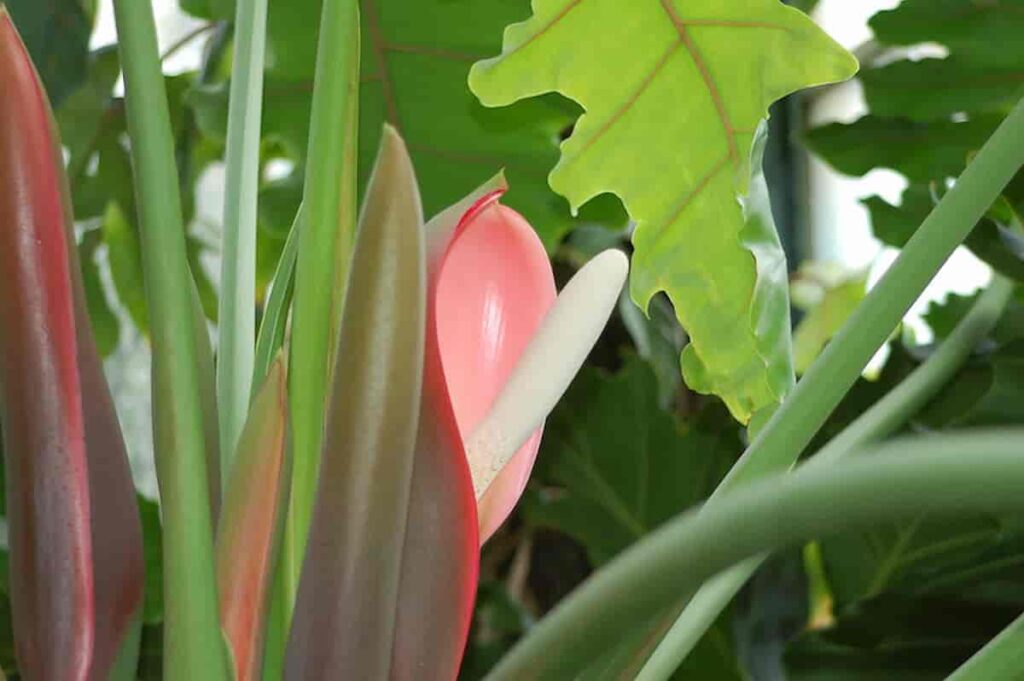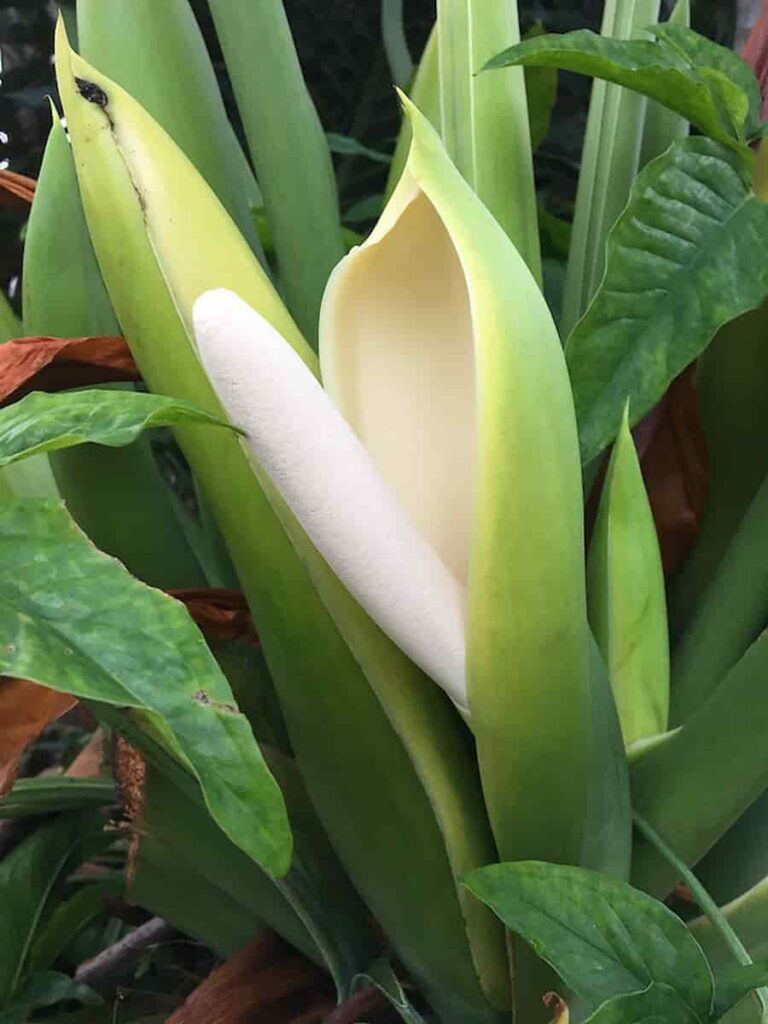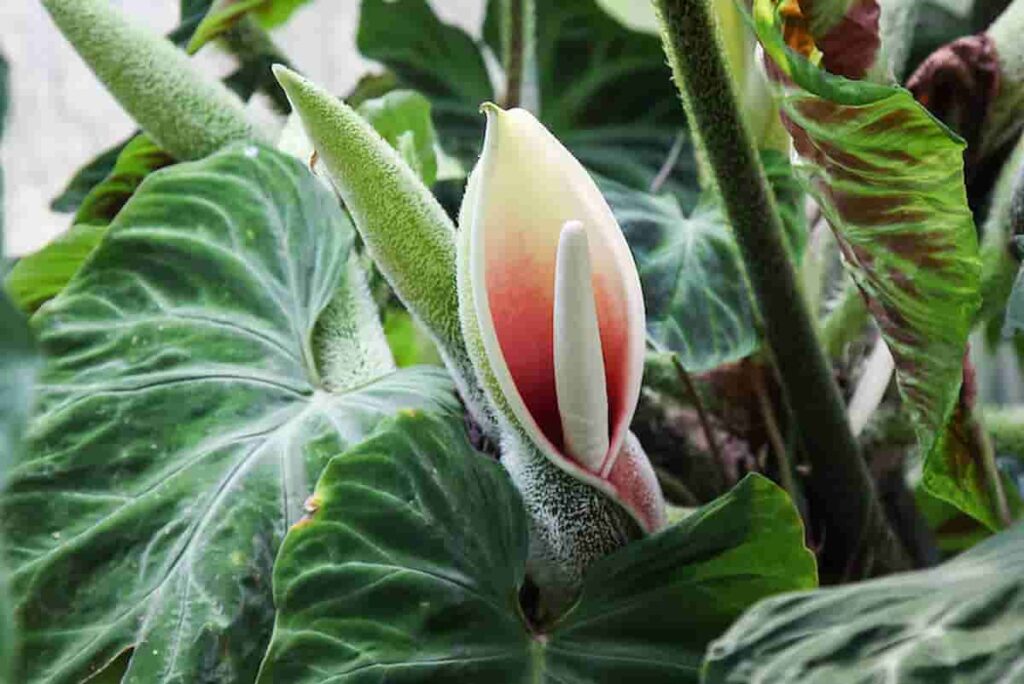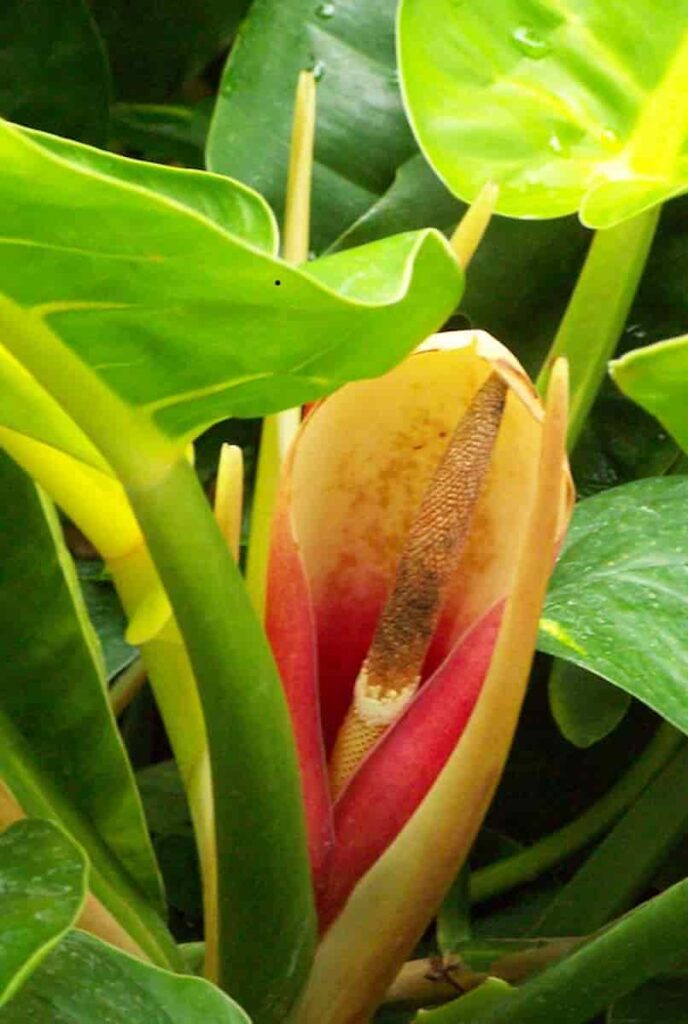If you’re looking for a houseplant that adds elegance with a touch of the tropical, look no further than the philodendron. Philodenrons have long been a staple for indoor gardeners.
Not only do they look pretty, but they are not too picky when it comes to their growing requirements. The perfect combination for the not-totally-obsessed houseplant collector!
And while these plants are mainly grown for their attractive foliage, you may be wondering if the philodendron flowers ever, just in case you can expect a nice little surprise on your plant one day.
Keep reading to find out!

Table of Contents
Do philodendrons have flowers?
Philodendrons do flower, although the plant has to be mature before it starts to produce flowers, which can take up to 15 years. In addition, it’s particularly rare for indoor philodendrons to flower. This means that you may, unfortunately, never see your plant bloom.
Once the philodendron has reached maturity, however, it can flower every year from May to July.
Regarding philodendrons grown indoors, as mentioned, you may never see your indoor philodendron produce flowers. It can be a little upsetting that your plant won’t bloom, but the philodendron produces stunning leaves, which makes up for not blooming.
Does philodendron imperial green flower?
The philodendron ‘Imperial Green’ does produce flowers. Their blooms are white in color and have a sweet, pleasant aroma. With that said, however, this plant is grown more for its glossy green foliage than the small white flowers it produces.
Remember, however, that it is not common for the philodendron ‘Imperial Green’ to not produce flowers when grown indoors. Even if you give the plant all the care that it needs, the chance of it flowering is highly unlikely.

Does philodendron Hederaceum flower?
Philodendron Hederaceum produces small, white flowers. Unfortunately, the flowers aren’t as prominent or even commonly seen when grown indoors as a houseplant. This means that if you are expecting to see an abundance of blooms on your philodendron Hederaceum, you will probably be disappointed.
This is because philodendrons in general do not typically flower when grown indoors. To order to see their blooms, the plant will need to be grown indoors in USDA hardiness zones 9 to 11. But even then, the plant may still not bloom since it is not in its native habitat.
Does philodendron moonlight have flowers?
Philodendron Moonlight does flower, producing a white spadix that’s surrounded by a reddish or pinkish spathe. The spadix is about the same thickness as the plant’s main stem, and can blend into the plant. This philodendron species has a bloom time that can last for over a month.
Don’t be concerned if your philodendron moonlight hasn’t produced flowers. The truth is, philodendrons typically don’t bloom when grown as houseplants. This doesn’t mean you’ve done anything wrong, this is just the sad fact about growing philodendrons indoors.
Does the heart leaf philodendron flower?
The heart leaf philodendron produces a spathe, which is often called a flower but isn’t actually a flower. The spathe is more similar to a flower holder than an actual bloom, and the spathe on the heart leaf philodendron is green in color and has an oval shape.
Additionally, this spathe typically appears in the summer, although can emerge at any time during the year.
Like other philodendrons, however, the heart leaf philodendron is not likely to bloom if it is grown inside as a houseplant.

Does philodendron Xanadu flower?
Philodendron Xanadu produces dark red spathes, which is often considered a flower even though it isn’t the same thing. With that said, however, these plants rarely flower when grown indoors. In its native environment, however, this plant can flower every year.
How do you get a philodendron to flower?
The best way to get a philodendron to flower is to ensure all of its care needs are met. However, keep in mind that a philodendron won’t flower until it reaches maturity so if your plant isn’t old enough, you will simply have to be patient in waiting for it to bloom.
While there is no guarantee that your philodendron will flower, there are some things you can do to help keep the plant happy and healthy. When a philodendron is thriving, it is more likely to flower than one that is sickly and unwell.
1. Give the philodendron the right kind of light
Philodendrons cannot tolerate direct sunlight, and can actually tolerate only 2 to 3 hours of sunlight every day.
However, if you want to ensure your plant has the optimal care, meet your philodendron’s light requirements by giving it at least 6 to 8 hours of bright, indirect sunlight every day.
2. Water the plant when the soil starts to dry
Philodendrons like their soil to be moist without being soggy. In fact, these plants cannot tolerate soggy roots.
In most cases, watering about once every week is sufficient for these plants. With that said, however, you should always test the soil moisture before watering and only water when the soil starts to feel dry.
Related: The Absolute Best Soil for Philodendrons to Thrive
3. Keep the temperatures warm throughout the entire year
Philodendrons grow best when they have daytime temperatures of 75 to 85 degrees and nighttime temperatures of 65 to 70 degrees. Never expose the plant to temperatures below 60 degrees for an extended period of time.
Exposing the philodendron to low temperatures can cause the plant to go into shock. Not only does this open the plant up to potential diseases and pest infestations, but it also will lead to your philodendron not growing much – or at all.
Related: What is a Philodendron’s Growth Rate (+ How To Grow It Faster)?
4. Humidity levels should be above 50 percent
Philodendrons are native to a tropical region, which means they are exposed to high levels of humidity. Because of this, you will need to increase the humidity level around the plant to above 50 percent. Drip trays and humidifiers work well to keep the humidity levels high.
5. Grow the philodendron in soil that drains well
The type of soil the philodendron is growing in has a direct effect on the overall health of the plant. Growing the plant in soil that doesn’t drain properly will increase the chance of pest and disease problems, and prevent the plant from flowering.
That is why it is vital that the philodendron has soil that is light, airy, and well draining. There are special potting mixes created specifically for philodendrons that work well to keep the plant healthy.

6. Watch out for pests
Pests can quickly turn your healthy philodendron into a stressed mess. That is why it is important to regularly examine the plants for pest problems, such as spider mites and mealybugs, and treat them with insecticidal soap if pests are found.
7. Use the best water possible.
Philodendrons are susceptible to additives in water, such as excessive minerals and chlorine. When they are hydrated with water containing these additives, the overall health of the plant can suffer. Thankfully, you can prevent this from occurring by being mindful of the type of water you give the plant.
Rain water, distilled water, filtered water, and spring water are all good choices for philodendrons. If you must use tap water, fill the water jug with the tap water the night before and let the water sit on the counter overnight. This will give the chlorine in the water a chance to dissipate.
Related: Watering Your Philodendron: The Ultimate Guide
8. Fertilize the philodendron, but not too much.
Fertilizing your philodendron is a wonderful way to give your plant a boost and help encourage it to flower. Use a balanced liquid fertilizer applied once a month during the philodendron’s active growing period. Reduce the application timeframe to once every 8 weeks during the fall and winter months.
Refrain from applying the wrong fertilizer or too much as this can lead to a build up of minerals in the soil, which will impede the plant’s growth. If you do overfeed the philodendron, you will have to flush the soil by placing the plant under running water for several minutes to get rid of the excess minerals.
You may also be interested in: Fertilizing Your Philodendron: The Ultimate Guide
Do philodendrons flower indoors?
Unfortunately, philodendrons rarely bloom when grown indoors. In fact, a lot of indoor gardeners are not even aware that the philodendron can produce flowers simply because their plant never blooms. Even without flowers, however, this plant is still a wonderful choice for gardeners of all skill levels.
Some gardeners have success with hand pollinating their philodendrons grown indoors. While their success varies, it is worth a shot if you want to try to encourage the philodendron to flower even as a houseplant. Just remember that even with hand pollination, the philodendron may still not bloom.
What do philodendron flowers look like?
Philodendrons don’t flower in the traditional sense of the word. Instead, they produce spadix and a spathe. The spathe is often thought of as a hood that protects the spadix, which is located in the center of the spathe. The spadix is usually long with a corn cob-like shape.
This makes it similar to a peace lily, whose “flower” is also not actually one. That doesn’t make it any less attractive though!
Do philodendron flowers smell?
With over 450 species of philodendrons out there, it can be difficult to determine whether all their flowers have a smell. In general, however, the philodendrons that do produce flowers do have a pleasant aroma. Most people would describe their scent as lightly sweet.
How are philodendrons pollinated?
Philodendrons are not self-pollinating plants. That doesn’t mean two plants are needed, however, since the plant can still be pollinated by itself. It just needs a second flower. In its native habitat, the scarab battle will collect the pollen from one flower and either crawl to other flowers on the plant or crawl onto another philodendron.
If the plant has only one bloom, you will need to either use pollen from a different plant or use pollen from a different flower from that same plant. This alone can make trying to pollinate the philodendron a difficult task.

How do you pollinate a philodendron flower?
In the wild, philodendrons are often pollinated by scarab beetles. When grown as a houseplant, however, it is left to the gardener to try to pollinate the philodendron by hand. To do this, you need to wait until the plant is in the female cycle.
When this occurs, the spadix will open and the plant will be fertile for about 48 hours. However, you will need the pollen of a second philodendron plant in order to pollinate the first plant.
If you have the pollen of a second plant, you can rub said pollen onto the philodendron’s spadix. Some experts recommend doing this at night, which is when they say the plant is more likely to reproduce.
How do I collect pollen from my philodendron flowers?
Pollen will need to be collected from the spadix during the male cycle. This cycle typically begins a couple of days after the female cycle.
In order to harvest the pollen, you will need a flat container, preferably glass, or a piece of tissue. Hold the glass or tissue under the spadix and gently shake it so that the pollen falls off and into the glass or tissue.
How do I save the pollen I collect from my philodendron?
Philodendrons cannot be pollinated by the same flower, so you will either need a second plant or a second flower to emerge from the original plant. In many cases, you won’t be able to use the pollen you just collected and will instead need to save it.
To save the harvested pollen, transfer it to an airtight container and then store in your freezer. When ready to use, remove the pollen from the freezer and let thaw for about an hour before using.

How do I use the pollen harvested from my philodendron?
Unlike some other houseplants, philodendrons are not designed to self-pollinate. This means that they rely on nature and pollinators to spread their pollen from the female part to the male part. This is because the female and male parts of the philodendron are not both active at the same time.
So you will need to hand pollinate the philodendron with the pollen you collected.
When you’re ready to use the harvested pollen, you will need to simulate the natural pollination process. This will require taking a soft brush, such as a small toothbrush, and gently brushing the pollen onto the pistils of the philodendron.
Can I move my philodendron outdoors to be pollinated naturally?
While it is possible to move your philodendron plant outdoors during periods of warm temperatures, that doesn’t mean the plant will be pollinated naturally. This is because a philodendron needs another philodendron for pollination, and unless you know your neighbor has philodendron plants sitting outside at the same time as you, the plant won’t be pollinated.
That said, if you live in the right area for your philodendron to live outdoors, there’s no reason why you couldn’t try!
Can I cross pollinate a philodendron with a monstera?
Unfortunately, you cannot cross pollinate these two plants to create a hybrid. Even though these two plants are often confused with one another, it isn’t possible to take the pollen from one and use it to pollinate the other.
Trying to pollinate these two plants will not create hybrid seeds, and you will merely be wasting your time.
